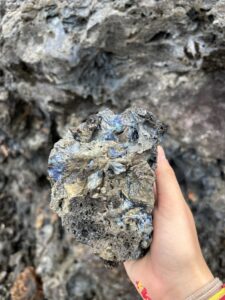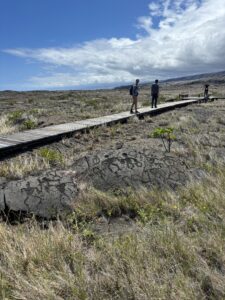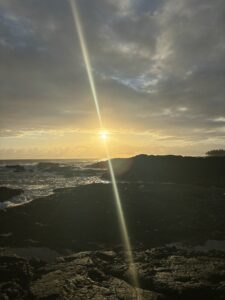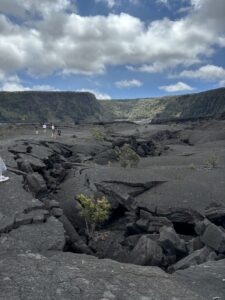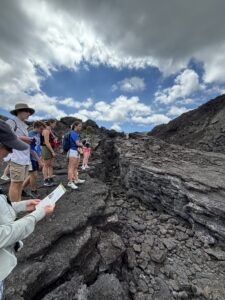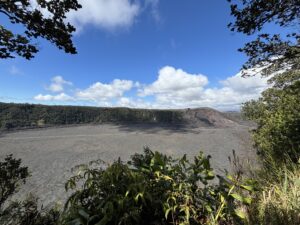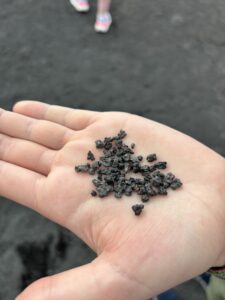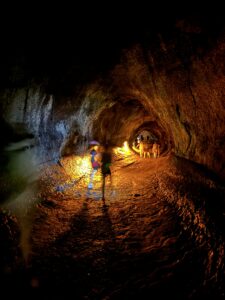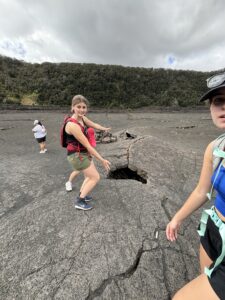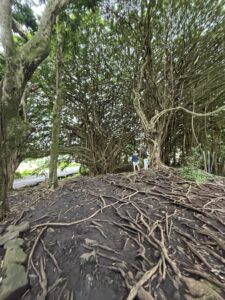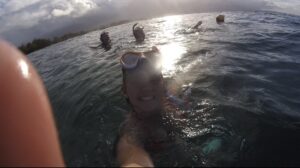I started off my day this morning at 7:00AM, and went to church at 8! Church was great to attend this morning, especially in Hawaii and on Mothers Day. It was really interesting to see the Hawaiian culture to be even in religious areas! Some of the service was in Hawaiian which was super interesting.
I went back and called my parents, and wished my Mom a happy Mothers Day! Everyone. If you are reading this on Mothers Day, stop right now and wish a Mom in your life a happy day!


After this, we loaded up the vans to go to visit the lava trees. The lava trees and the lava tree molds were formed after the 1790 Kilauea eruption. The trees are filled with lots of water. When lava surrounds them, the water evaporates, and as the tree cools, it insulates itself from the lava, encasing it and forming a lava tree. To form a lava tree mold, which is in the ground, the tree actually catches fire and fully burns. Sometimes, in lava tree molds, the texture of the bark can be seen! The lava trees and the lava tree molds have a large geological importance, as they can show the direction of the lava flow, the date of the eruption, and more important information!
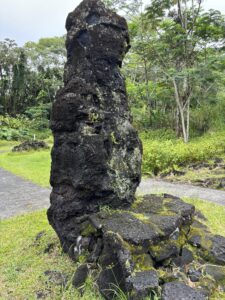

After this, we visited a local couple who lives by fissure 8. Yesterday at the farmers market, Professor Knapp was looking at an art gallery and met one of the artists who lives by that fissure and she invited us to see the fissure and her house, and to have a pizza party with them!
They had a beautiful house, full of Nicole’s artwork.
Before the LOVELY and DELICIOUS pizza party, we went to the edge of the lava by the cinder cone created by the 2018 kilauea eruption. 700 homes were taken and destroyed by this eruption, but there were 0 deaths. Fissure 8 was the most destructive out of all of the fissures. Unfortunately, there is no lava insurance for Hawaii, so the people who lost their homes, lost everything. At the edge of the lava flow, we saw “kapu” etched into the lava that bordered a burnt fence on the outer edge of a burnt driveway. “Kapu” translates to “no trespassing” or “forbidden”. We did not go further into this lava flow, as it would be quite inappropriate considering underneath it lay people’s entire homes and belongings. Sadly, the homeowners now own parts of that cinder cone.


After listening to the eruption stories from the kind couple that welcomed us, we said our goodbyes and headed toward Kaimu, which is a beach by Kalpana. Kaimu literally means gathering at the sea. It was a large lava flow that was formed in 1990 from the Kilauea lava flows. It buried most of the original black sand beach. The black of the sand is from the volcanic basalts. Today, we did not see any black sand since the tide was in, but usually you can see it. The place is a symbol of regrowth and return with the immense vegetation regrowth after the lava flows. The surrounding community cleared up these lava flows and labeled some plants for non-natives, after some groups graffitied and took over the lava rocks.


We then headed to Isaac Harbor and the pohoiki’s that surround it. Isaac Harbor was the primary working boat harbor to its surrounding community, and was taken over by lava in 2018. The lava entering the water creates some glassy basalt and laze (gaseous HCl). This glassy basalt now created the largest and most new black sand beach in Hawaii.

Here is some background information that I lectured on before I dive into Puna Hot Springs…
Puna is known to be Pele’s workshop, where the volcano goddess continually creates and recreates land. Puna is the area from kilauea’s summit east to the sea, and is where the hot springs are!
Now…
Pohoiki in Hawaiian literally means small hole, fitting due to the size of the spring. Most of the hot springs existed before the 2018 eruption, which created the biggest black sand beach on the island as I’ve previously mentioned. The lava flow from this eruption also formed surrounding springs that are larger but with less consistent temperatures.
The pool was formed in a collapsed lava tube. The groundwater is heated by volcanic activity in the eastern rift zone of the Kilauea volcano. The pools are filled with rainwater that is heated to around 100 degrees and as it flows above the lava underground and mixes with cool sea water, the water temperature is around 98 degrees. The smaller pohoiki is about 4 feet deep. This spring also has hundreds of red shrimp, called ʻōpaeʻula,. It is said that they surround the warmer part of spring, and they sometimes move over peoples skin! Unfortunately, these hot springs typically are areas characterized by low oxygen levels, low light levels and high concentrations of sulfur and calcium carbonate, so they have adapted microbes/bacteria. Due to this, the EPA and the state suggest not entering if there are any open cuts or sores. And if entering, then do not dunk your head or get water in your mouth, and shower after.
That’s all the information I lectured about today at the Pohoiki!
We then went home, and are currently binging some movies! Last night in Hilo 🙁
First was the newest Jumanji, and now we are in a thriller! Hopefully tomorrow we will have some good weather for a lovely sunrise and snorkel sesh!!
See yall next time!












